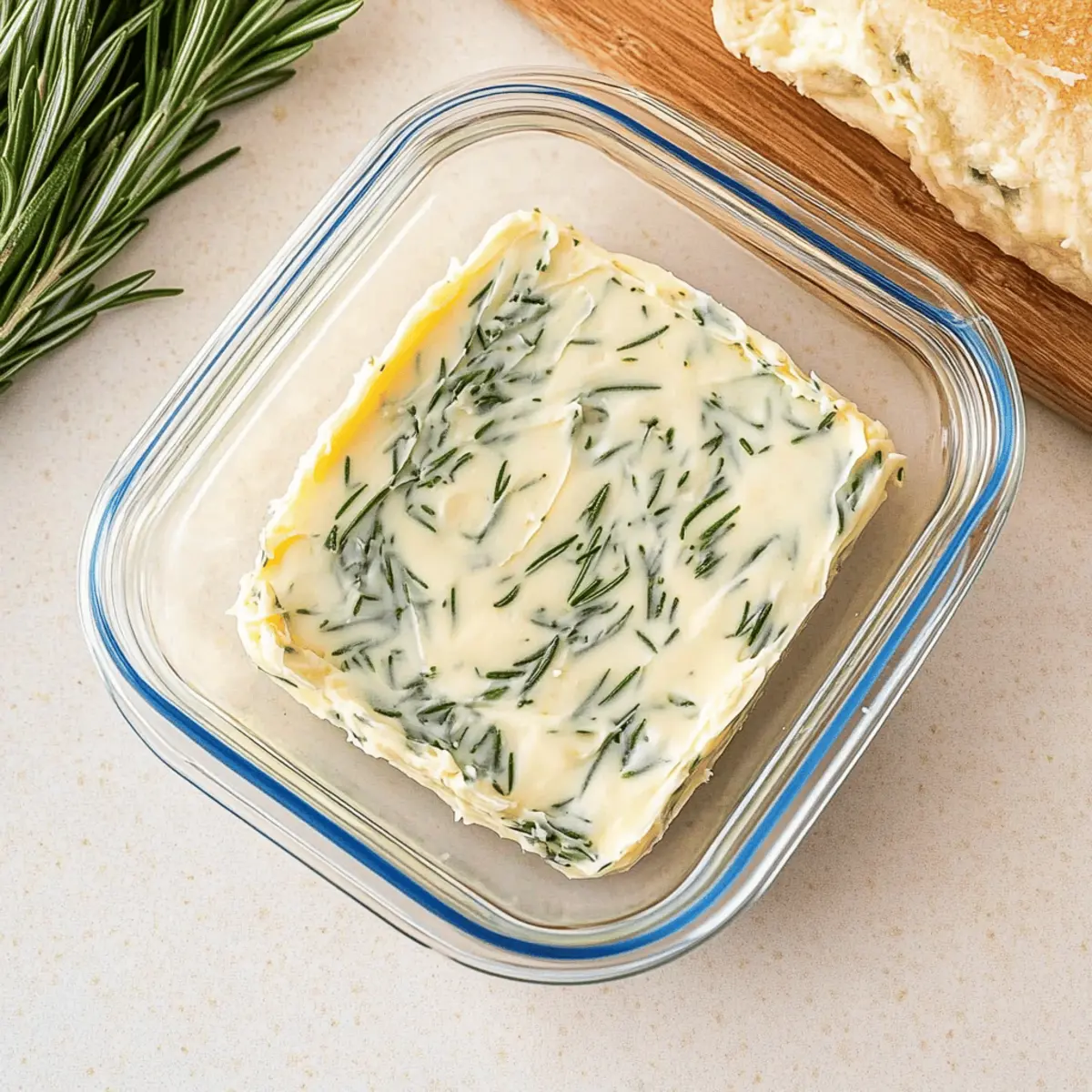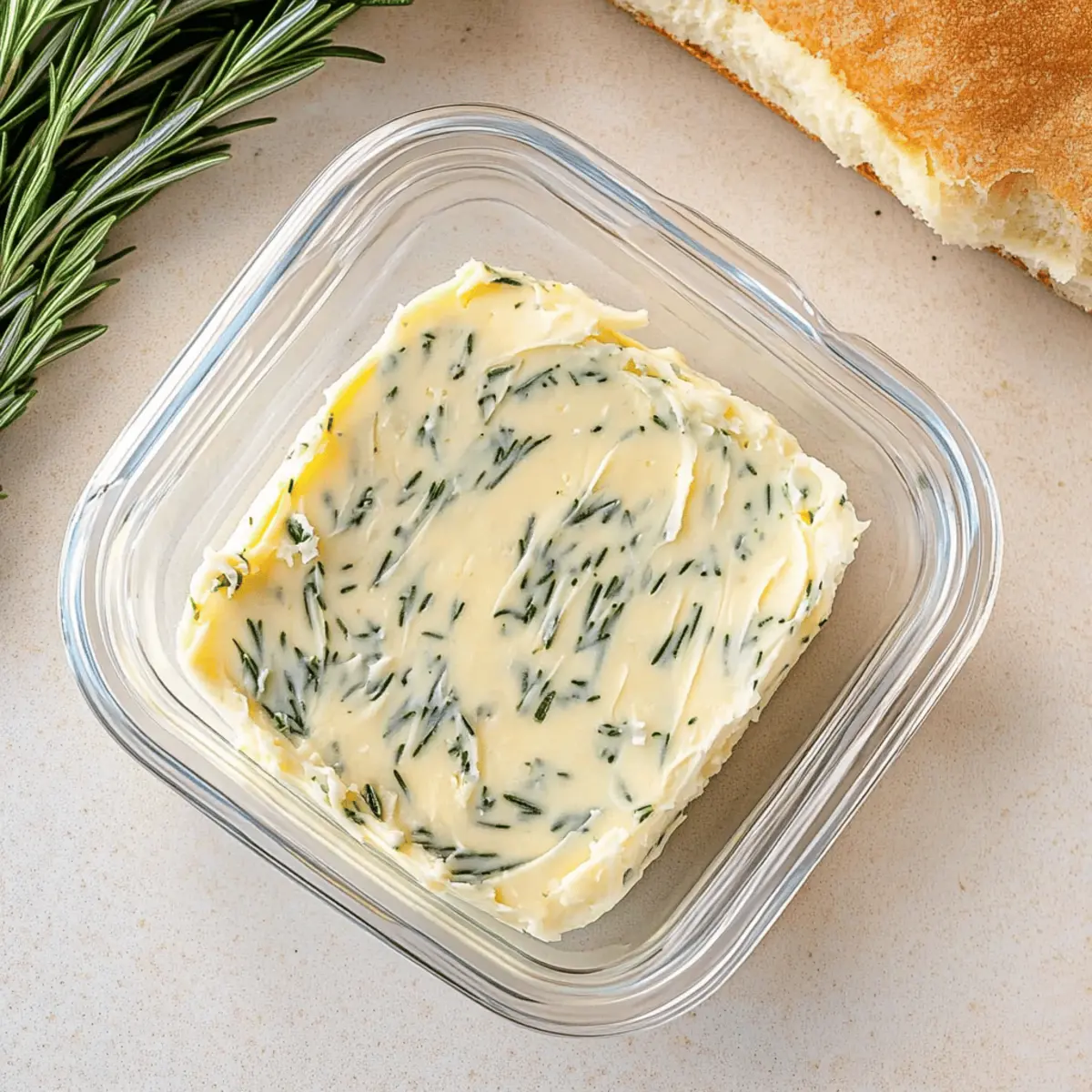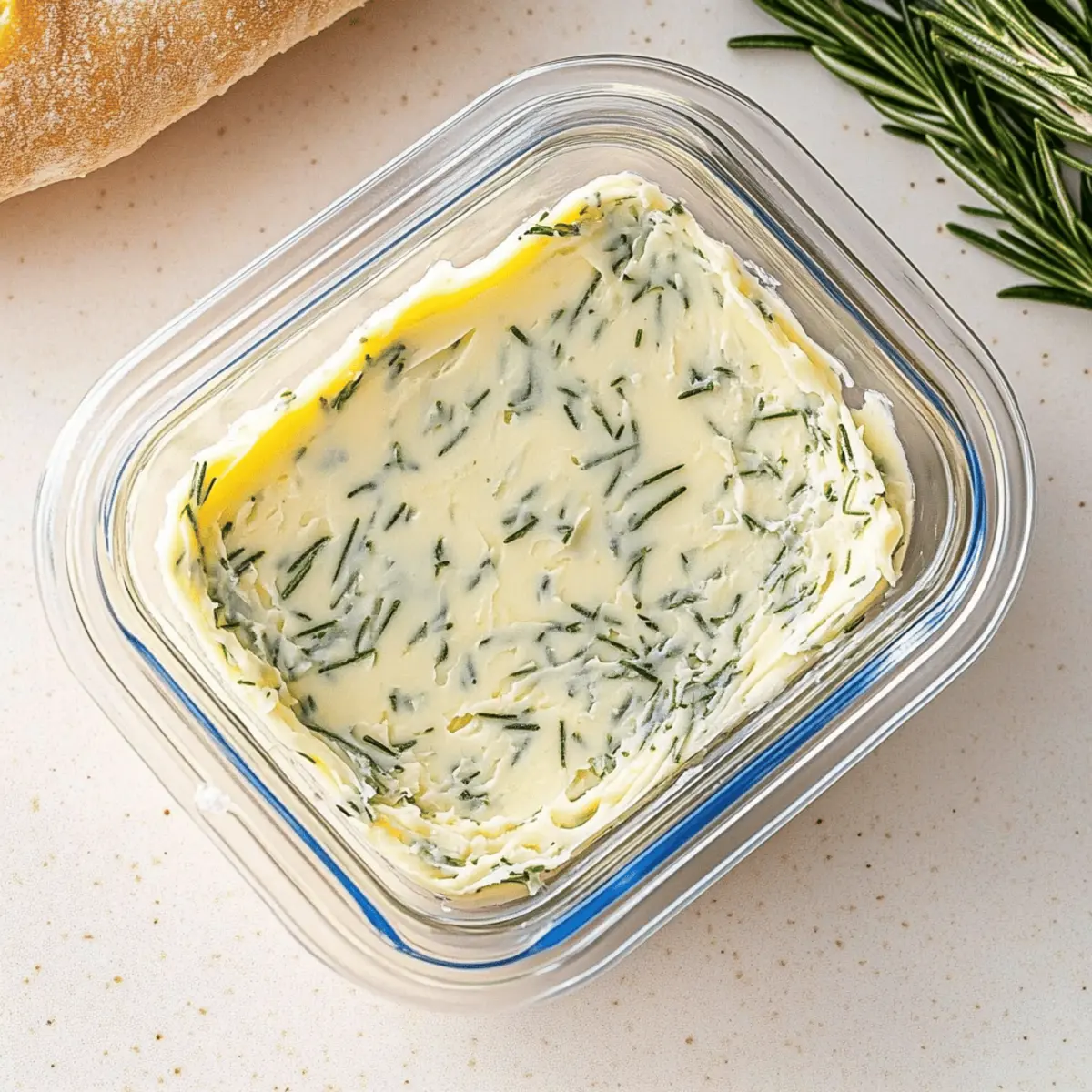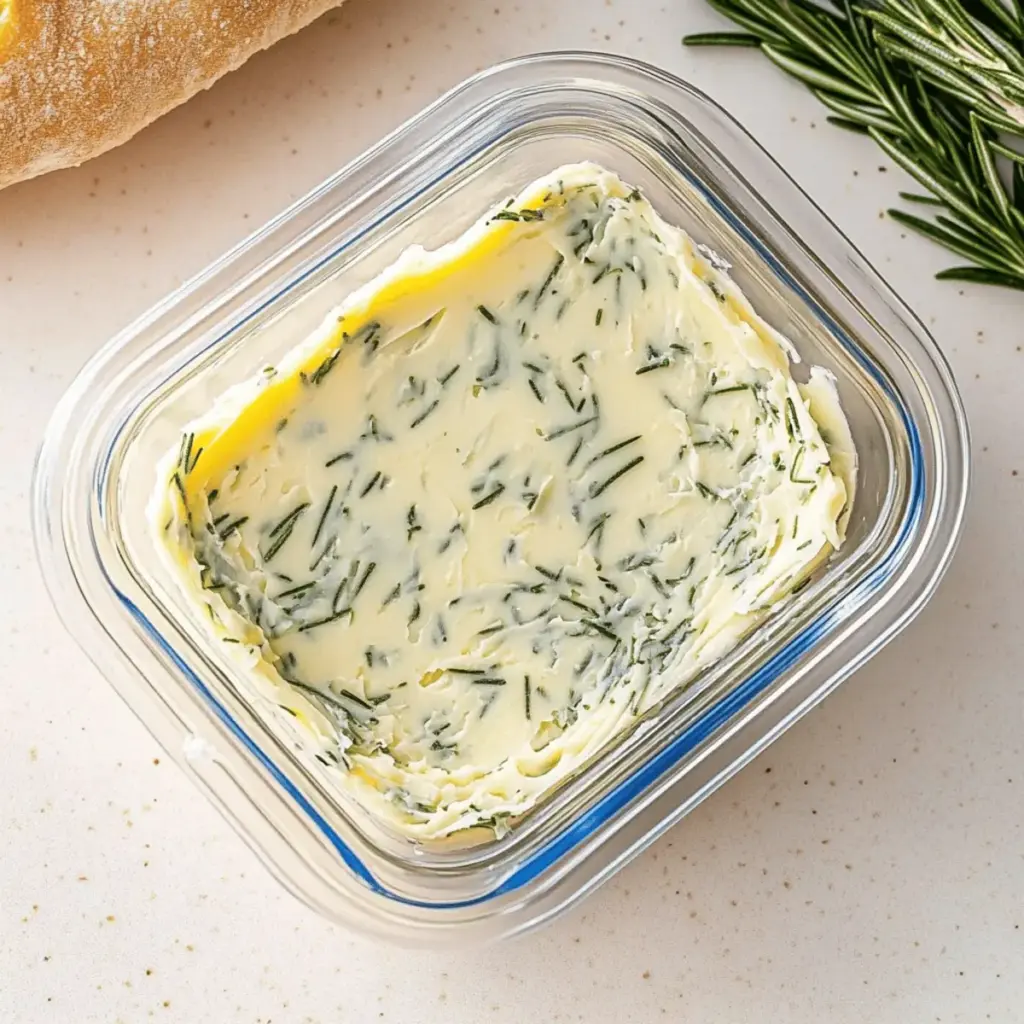As I unwrapped the creamy goodness of fresh herbs mixed into buttery bliss, the aroma of rosemary danced through my kitchen, instantly elevating my mood. This easy homemade rosemary butter isn’t just a recipe; it’s a culinary secret that transforms mundane meals into delightful feasts. With a mere handful of ingredients, this versatile compound butter packs a punch in flavor and is perfect for everything from succulent steaks to roasted vegetables. Not only is it quick to prepare, but you can whip it up ahead of time, ensuring you always have a gourmet touch ready to enhance your dishes. Are you ready to bring comfort and joy to your meals with this aromatic wonder? Let’s dive in!

Why is Rosemary Butter a Game Changer?
Flavor Explosion: This easy recipe bursts with aromatic goodness, bringing a gourmet touch to your everyday meals.
Versatile Use: Perfect for grilled meats, roasted veggies, or slathered on fresh bread. Elevate your dishes effortlessly!
Quick to Prepare: With just a few ingredients, you can whip up this compound butter in no time, making it a go-to for busy weeknights.
Make Ahead Magic: You can prepare it in advance and keep it refrigerated, ready to transform your culinary creations at a moment’s notice. If you enjoy savory delights, try pairing it with Garlic Butter Chicken or serve it alongside a fantastic steak like in my Garlic Butter Steak.
With its creamy texture and delightful aroma, this rosemary butter is sure to become a staple in your kitchen!
Rosemary Butter Ingredients
• Here’s everything you need for your delicious rosemary butter!
For the Butter
- Unsalted Butter – softening your butter allows for easier mixing and a creamy texture.
- Rosemary – using 3 to 4 tablespoons of finely diced fresh or dried rosemary infuses incredible aromatic flavor.
- Salt – ¼ teaspoon enhances the overall flavor; feel free to adjust to your taste!
- Pepper – ⅛ teaspoon adds a subtle warmth; consider black or white pepper as alternatives.
- Garlic Powder – ¼ teaspoon contributes a savory depth; fresh minced garlic can offer a bolder taste.
This irresistible rosemary butter will be a delightful addition that elevates any dish!
Step‑by‑Step Instructions for Rosemary Butter
Step 1: Combine Ingredients
In a medium-sized mixing bowl, add your softened unsalted butter, finely diced rosemary, salt, pepper, and garlic powder. Using a spatula or a sturdy fork, thoroughly mix everything together until the ingredients are well incorporated, and the mixture appears creamy and uniform in color. This should take about 2-3 minutes of gentle mixing.
Step 2: Form the Butter
Once your rosemary butter blend is creamy, it’s time to shape it. If you prefer a log form, lay a piece of plastic wrap on your countertop. Spoon the rosemary butter mixture onto the wrap and shape it into a log by rolling the wrap tightly around it. Twist the ends to secure and form a neat cylindrical shape. This method not only keeps it fresh but also makes it easy to slice later.
Step 3: Chill and Store
Transfer your wrapped rosemary butter log to the refrigerator and let it chill for at least 1 hour. This allows the flavors to meld beautifully. If you’ve opted for a container, simply cover it with a lid. When you take it out, the butter should be firm but spreadable. You can store it in the fridge for up to 2 weeks or freeze it for longer-lasting enjoyment.
Step 4: Use Your Rosemary Butter
Your delightful rosemary butter is now ready to enhance your dishes! Slice off portions as needed and let it soften just slightly at room temperature before serving. This herb-infused butter is perfect melted over grilled meats, whisked into vegetables, or spread on freshly baked bread, adding a burst of flavor to your culinary creations.

Expert Tips for Rosemary Butter
-
Room Temperature Butter: Use softened butter for easier mixing; cold butter can lead to a lumpy texture in your rosemary butter.
-
Flavors Meld: Let your butter rest for a few hours after preparation to enhance the flavors; this step makes a significant difference in taste!
-
Keep it Fresh: Store your rosemary butter in an airtight container in the fridge for up to 2 weeks or freeze it for up to 3 months, ensuring you always have some on hand.
-
Custom Variations: Get creative with your compound butter! Substituting rosemary with thyme or adding lemon zest can create fantastic new flavor profiles.
-
Slicing Cold Butter: If you’ve frozen your butter, let it sit at room temperature for a few minutes before slicing to achieve clean cuts.
Make Ahead Options
These creamy rosemary butter delights are perfect for meal prep enthusiasts! You can mix the ingredients and shape the butter into a log up to 24 hours in advance, allowing the flavors to meld beautifully in the refrigerator. Once shaped, simply wrap it tightly in plastic wrap and store in an airtight container. If you want to prepare further ahead, freeze the butter for up to 3 months; just slice off portions as needed. When you’re ready to elevate your dishes, allow the frozen rosemary butter to thaw in the refrigerator overnight or let it sit at room temperature for a bit before serving. Enjoy the convenience of having this gourmet touch ready to enhance your meals with minimal effort!
How to Store and Freeze Rosemary Butter
Fridge: Keep your rosemary butter in an airtight container for up to 2 weeks, ensuring it stays fresh and flavorful.
Freezer: For longer storage, freeze the butter in log form or in small portions for up to 3 months. Wrap tightly in plastic wrap or use a freezer-safe container to prevent freezer burn.
Reheating: When ready to use, simply slice off the desired amount and let it soften at room temperature for easy spreading. You can also melt it directly over your dishes for a burst of flavor.
Rosemary Butter Variations & Substitutions
Feel free to mix and match flavors and ingredients to create your perfect rosemary butter blend.
-
Herb Swap: Substitute rosemary with other herbs like thyme, basil, or parsley for a fresh twist. Each herb brings its unique aroma and flavor profile, allowing for endless combinations.
-
Citrus Burst: Add 1 teaspoon of lemon zest to introduce a refreshing citrusy kick that brightens the butter and balances savory dishes.
-
Cheesy Delight: Incorporate 2 tablespoons of grated parmesan cheese for a rich, deliciously creamy Italian twist that enhances flavors in pasta and bread.
-
Heat It Up: Mix in a pinch of red pepper flakes or a dash of cayenne for a spice-filled version that adds warmth to your favorite grilled meats.
-
Nutty Flavor: Toasted chopped nuts, like walnuts or almonds, can be folded into the butter for a delightful crunch and an unexpected depth of flavor.
-
Smoky Surprise: Adding liquid smoke or smoked paprika will infuse a unique smokiness—perfect for barbecued dishes or roasted vegetables.
-
Garlic Lover’s Twist: For extra garlicky goodness, substitute garlic powder with fresh minced garlic. The bold flavor pairs beautifully with the buttery smoothness.
-
Sweet Herb Infusion: For a different approach, try mixing in 1 tablespoon of honey alongside the rosemary for a sweet-herbal butter that works wonders on biscuits or cornbread.
These variations help you create a personalized herb-infused butter! Elevate your meals further by pairing this rosemary butter with dishes like Garlic Butter Chicken or using it as a flavorful spread on freshly baked bread alongside your favorite Homemade Danish Butter.
What to Serve with Easy Homemade Rosemary Butter
As you bask in the delightful aroma of rosemary wafting through your kitchen, consider how to create the perfect meal experience.
-
Grilled Chicken: The savory notes of rosemary butter perfectly enhance grilled chicken, adding richness that elevates each bite.
-
Roasted Vegetables: Toss assorted veggies in rosemary butter before roasting for a beautifully caramelized, flavorful companion to any dish.
-
Crusty Bread: Spread this herb-infused butter on warm, crusty bread, transforming simple slices into a heavenly appetizer.
-
Steak: Let the aromatic butter melt atop a juicy steak, enhancing its flavor while offering a luxurious, mouthwatering finish.
-
Baked Potatoes: A dollop of rosemary butter on a baked potato adds a velvety layer of herby goodness – comfort food at its finest.
-
Pasta Dishes: Stirring in rosemary butter to pasta creates an easy yet indulgent sauce, elevating your weeknight dinners with minimal effort.
-
Fish Fillets: Pair this butter with pan-seared or baked fish to complement its delicate flavors and add a touch of sophistication.
-
Mushroom Risotto: Incorporating rosemary butter into mushroom risotto creates a depth of flavor that feels gourmet while staying comforting.
-
Savory Scones: Use rosemary butter in biscuit or scone recipes for delicious breakfast treats that burst with flavor and warmth.

Rosemary Butter Recipe FAQs
How do I select the best rosemary for my butter?
Absolutely! When selecting rosemary, look for fresh sprigs that are vibrant green and fragrant. Avoid any that appear wilted or have dark spots. If using dried rosemary, ensure it’s aromatic and free from any moisture or clumping.
How long can I store rosemary butter in the refrigerator?
You can keep your rosemary butter in an airtight container in the fridge for up to 2 weeks. It’s best to check for any changes in smell or texture before using; if it starts to smell off or develops an unusual appearance, it’s time to discard it.
Advertisement
Can I freeze rosemary butter, and if so, how?
Very! To freeze rosemary butter, wrap it tightly in plastic wrap in log form or place it in small, freezer-safe portions. I often slice it into tablespoon-sized pieces before freezing for easy access. It can be stored for up to 3 months, just remember to label it!
What should I do if my rosemary butter is too salty?
If you find your rosemary butter is too salty, don’t worry! You can balance the flavors by mixing in a bit more unsalted butter. Start with 1-2 tablespoons of additional butter, mix it in thoroughly, and taste to see if it meets your preference.
Can pets eat rosemary butter?
It’s best to keep rosemary butter away from pets, especially dogs and cats, as they may not tolerate herbs well. Additionally, the butter itself can be high in fat, which might upset their stomach. If you’re looking for a pet-safe treat, consider plain, unsalted butter in very small amounts.
What if my butter is too hard to spread after refrigeration?
Very common! If your rosemary butter becomes too hard after chilling, simply let it sit at room temperature for about 15-20 minutes before using. This will allow it to soften to the perfect spreading consistency. Alternatively, you can microwave it for just a few seconds, but watch closely to avoid melting it completely!

Creamy Rosemary Butter for Effortless Flavor Elevation
Ingredients
Equipment
Method
- In a medium-sized mixing bowl, add your softened unsalted butter, finely diced rosemary, salt, pepper, and garlic powder. Using a spatula or a sturdy fork, thoroughly mix everything together until the ingredients are well incorporated, and the mixture appears creamy and uniform in color. This should take about 2-3 minutes of gentle mixing.
- Once your rosemary butter blend is creamy, it's time to shape it. If you prefer a log form, lay a piece of plastic wrap on your countertop. Spoon the rosemary butter mixture onto the wrap and shape it into a log by rolling the wrap tightly around it. Twist the ends to secure and form a neat cylindrical shape.
- Transfer your wrapped rosemary butter log to the refrigerator and let it chill for at least 1 hour. This allows the flavors to meld beautifully. If you've opted for a container, simply cover it with a lid. When you take it out, the butter should be firm but spreadable.
- Your delightful rosemary butter is now ready to enhance your dishes! Slice off portions as needed and let it soften just slightly at room temperature before serving.





